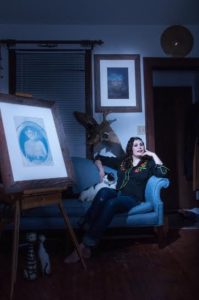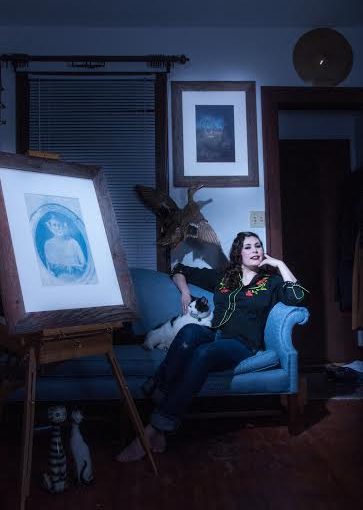
When Sabrina Hornung walked into the hip downtown coffee shop Youngblood, she looked every bit the artist in cat-framed glasses, a large trendy coat and bright red lips. Despite the modern appearance, Hornung’s art ties into her interest in history and tradition.
From a young age on, Hornung’s interest in the cultural heritage left behind by our pioneer ancestors only grew.
“My German relatives would come over, and we’d see these different areas of cultural and historical significance,” Hornung said. “My grandpa and I, we’d go out — he’s from Woodworth-Pettibone — and those two towns combined are about 100 people. We’d go out there and we’d see all these different abandoned houses and he knew the family’s stories. He’d give me the dirt, like, years of gossip.”
Trained in photography, Hornung’s collages are surreal representations of rural plains life. But what’s more interesting is her study in scherenschnitte, or German paper cutting.
Scherenschnitte is a delicate process requiring patience and determination. Using smooth silhouette paper, small scissors and an intricate pattern, artisans of the craft carefully create a paper image that is then glued onto tougher paper.
The German folk art tradition first piqued Hornung’s interest in the home of her grandparents.
Raised by her grandparents, Hornung described her home as “Little Germany.” Her grandmother emigrated from Germany in 1955 with Hornung’s grandfather after the war. Hornung remembers her grandmother playing German music and making German food.
“This had a big impact on my work because there was this cultural connection between Old Germany and rural North Dakota,” she described. “(My grandmother) always had an eye for folk art. Our Christmas décor was, like, this traditional German art. She would often talk about scherenschnitte. Anything that was like, this high contrast, black and white images would strike a sentimental chord. She’d be like, ‘Oh, that’s scherenschnitte, this is cut paper!'”
Hornung was able to pursue scherenschnitte through a grant from the North Dakota Council for the Arts. The grant was for a folk art and traditional art apprenticeship program hoping to perpetuate art traditions from the old country.
“Apparently, there aren’t that many people that practice scherenschnitte,” Hornung said. “But I was lined up with this lady (Meridee Erickson Stowman) in Tower City and we ended up spending, like, one day a week together cutting paper for six hours and drinking a pot of coffee.”
Within scherenschnitte and her photography, Hornung uses different influences to make unique pieces. As a North Dakota native, she often incorporates cowboys or western images, like cowboy boots, skulls or jackalopes, into her work. This also comes from Hornung’s interest in the history of the plains.
“There are places (out in the middle of somewhere) where people just kind of up and left. They leave everything behind. Or else they leave these little nuances,” Hornung said. “I think it’s really interesting. Even my parents, my mom and dad and I, we’d explore these abandoned houses or we’d explore these old graveyards.”
Hornung said she learns a lot from places like this about the people who once lived there and what it was like on the frontier. Plague years can be inferred from graves sites, abandoned houses offer looks into the daily lives of our ancestors and sometimes, the remnants of the old world still live in small towns.
“One cemetery that I came across was primarily Czech,” Hornung said. “The church there still does church services in Czech once a month, which I thought was kinda cool.”
This discovery of the past, and its connection to the present, is what drives Hornung to discover more about the people who lived here before us.
“I think our generation needs to do more about (connecting to the past),” the artist said. “We need to know our roots. I think it’s good to know where we came from.”
Hornung’s exhibition “Sod Breakin’ and Reclamation,” featuring her photography and scherenschnitte, can be seen at the Rourke Art Museum in Moorhead from now until Dec. 4.
